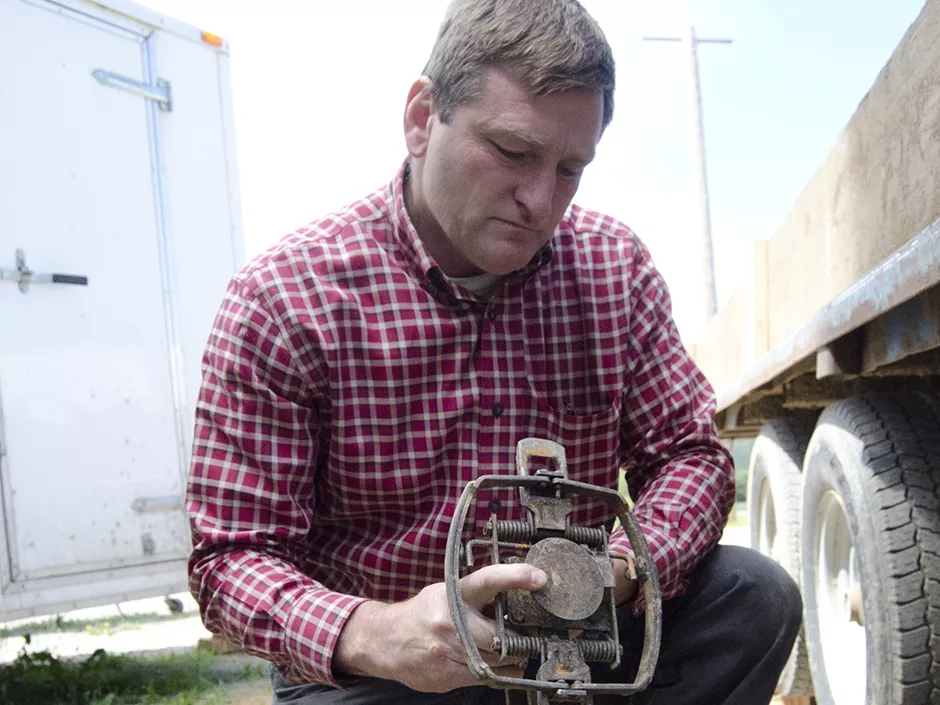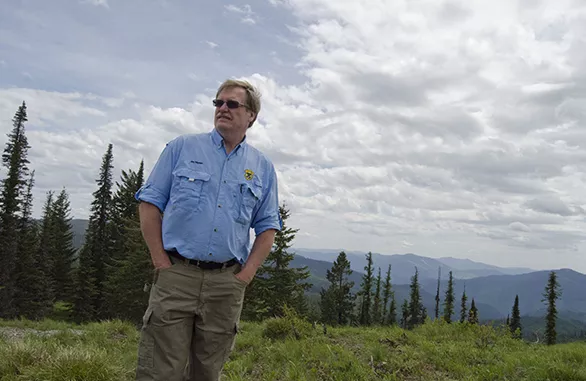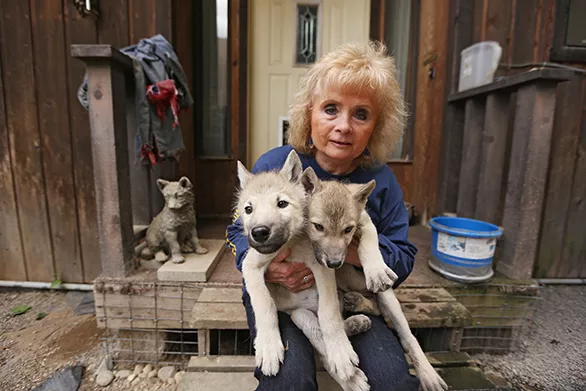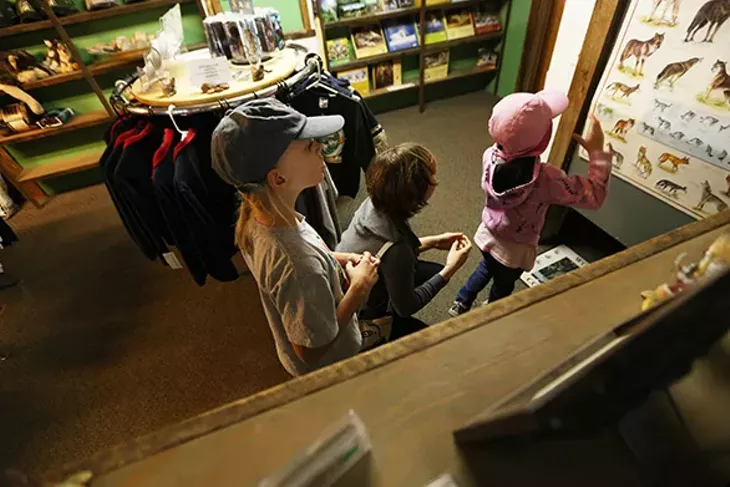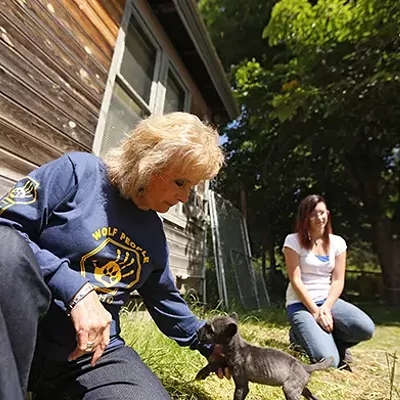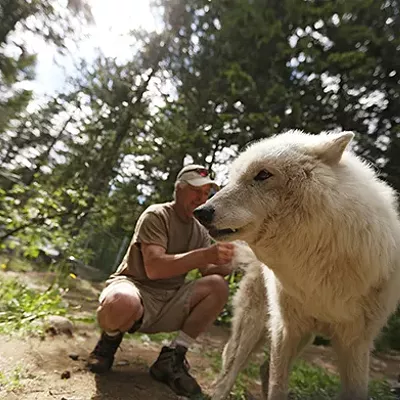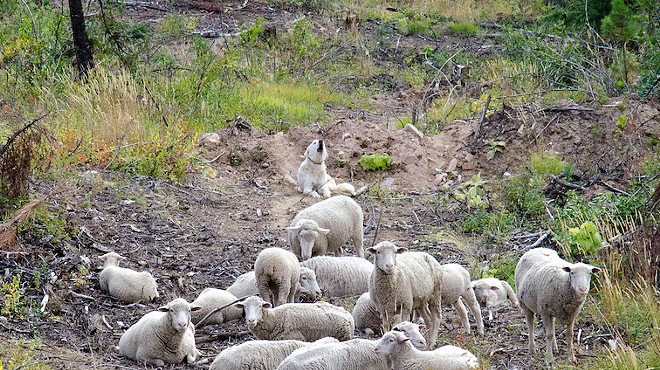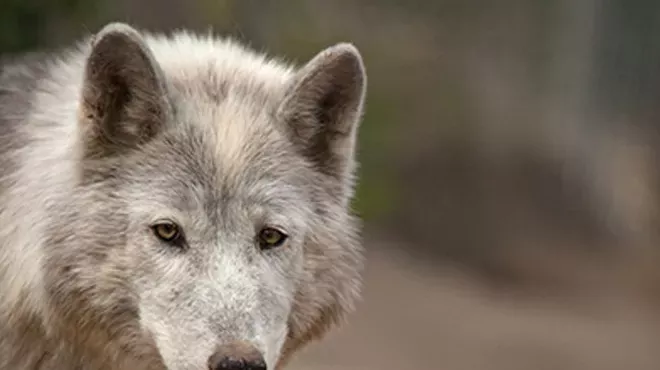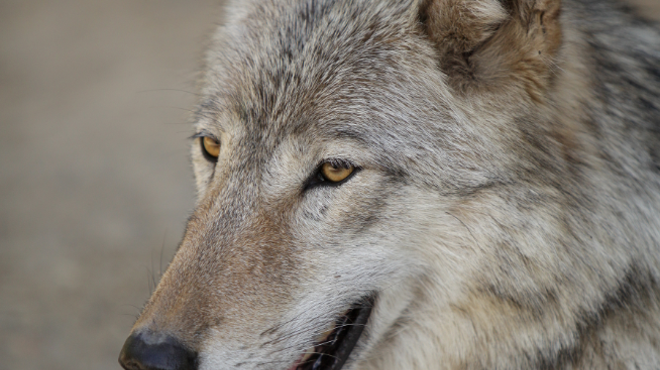Robert Roman cradles a pale wolf skull in his upturned palm. He does not hate wolves, he says, gripping the hollow eye sockets and turning the bleached bone in his hands. Perhaps God just built the wolf too well.
Working along the ragged jawline, Roman runs his thumb against the curved point of each tooth, edged almost like knives.
“These are for cutting,” he says. “These are for ripping.”
With powerful jaws and sharp instincts, wolves prey upon animals many times their size. Long-legged and swift, they run down moose, elk and deer. They tear flesh and crush bone.
“That’s a pretty good machine,” he says to the skull. “With the teeth and the strength and the size, they’re good at what they do.”
A 54-year-old logger and hunter from rural Post Falls, Roman has long wrested his living from the land. As wolves move back into Idaho — competing for scarce elk in some Panhandle regions — he has set out against his fellow predator.
Roman says he took this skull from his first wolf in 2011. Since then, 16 more wolves have fallen into his traps and snares. While thousands of Idaho hunters have stalked wolves over three recent seasons, just a few hundred have succeeded. Roman has likely claimed more than any other hunter or trapper in the state.
Since man first sought to break the wolf, the howling beast has stirred fear and mysticism. They haunt our fairy tales and folklore. They’re held as a symbol of the American West. The untamable dog, canis lupus, feels both familiar and foreign, a best friend to some and a savage enemy to others.
“People talk about their little dogs and things,” Roman says. “These aren’t little dogs, these are wolves — whole different ball game.”
Wiped out by settlers in the early 1900s, modern researchers spent more than two decades returning the gray wolf to the Northern Rocky Mountain areas of Idaho, Montana and Wyoming. Now numbering as many as 2,500, wolves have split the region along bitter battle lines as states have expanded hunting and environmentalists have repeatedly sued to continue recovery efforts.
A new fight now looms between wolf advocates, game managers, ranchers, conservationists and hunters: After nearly 50 years on the Endangered Species List, the U.S. Fish & Wildlife Service earlier this month proposed removing federal protections for gray wolves nationwide.
Jim Hayden, a regional wildlife manager with Idaho Fish & Game, says no other creature provokes as much passion or incites as much controversy:
“I’ve never met a more polarizing issue in my entire career than the wolf.”
In the high mountain country of North Idaho, gray wolves have roamed the pine-topped ridges and steep river drainages of the Coeur d’Alene Mountains for thousands of years. On a recent morning, Hayden steers his mud-splattered Fish & Game truck up a narrow dirt road near Bumblebee Peak, about 15 miles north of Kingston.
Hayden, who has managed the Panhandle region since 1991, plans to check a game camera set up to monitor a wolf “rendezvous site” from last year.
“This is the territory of the Bumblebee Pack,” he says, his tires rumbling over the washed-out ruts.
When settlers first took hold in Idaho, they declared war on the wolf, eventually wiping them out through intense hunting and the use of poison. Researchers believe the last Idaho wolves died off in the 1930s.
Public opinion shifted in the 1960s and ’70s with the introduction of the Endangered Species Act, which listed wolves as protected. By the 1980s, a few wolves had started to wander back into Idaho from Canada.
Federal wildlife officials jump-started wolf recovery in 1996 with a widely publicized transplant of 66 wolves into Yellowstone National Park and central Idaho. Within two years, the 35 wolves in Idaho had increased to 115.
Hayden says wolf numbers have continued to rise, passing all recovery benchmarks in 2002. With a rapid reproduction rate of about 29 percent a year, the wolf population has doubled every three years.
Idaho wildlife officials listed a minimum population of 683 wolves at the end of 2012, but Hayden says that number can nearly double in peak summer months. Officials count more than 2,500 wolves throughout the entire Northern Rocky Mountain region at peak times. In Washington state, biologists have watched closely as local wolf populations have ticked up in recent years. Wildlife managers most recently counted at least 51 wolves in 10 confirmed packs, mostly in the far northeast corner of the state.
Hayden excitedly checks the memory card from the game camera. It has captured a bobcat, a curious elk and two wolves — one less than 24 hours gone. He scouts the surrounding areas and finds a set of prints in the broken mud.
“We’re getting closer to them,” he says.
Wolves have had many successes. They have bucked expectations and brought new attention to wildlife preservation efforts. But hunters have been quick to blame wolves for declining elk numbers in some areas of the state.
As Hayden rounds a curve up a new ridge, he hits the brakes. He’s spotted something in the road.
“That’s interesting,” he says.
Covered in delicate fur, the tiny severed leg of a newborn elk calf rests in the dirt.
From behind a chain-link fence, the howling starts high, rolls off and then fades into a lonesome moan. Soon others join in the call, wails rising and overlapping as Nancy Taylor visits her wolf pens.
Blonde and soft-spoken, Taylor owns Wolf People, a wolf habitat and education center just off Highway 95 south of Sandpoint. The center keeps 23 adult wolves and four young pups in several enclosures.
“I’m kind of the mama of the pack,” she says with a laugh.
As many as 100 people a day visit the Wolf People center to learn about wolf behavior, history and recovery efforts. They can take up-close photos with the animals. A souvenir store stocks wolf T-shirts, wolf ties, shot glasses and postcards. Fluffy stuffed animals sit on the shelves. Tribal music with soft drums and flute plays over the stereo.
Taylor opened Wolf People about 20 years ago, shortly after moving to the area from Arizona. She says she started with wolf-dog hybrids, but quickly acquired several pure wolves to better share her passion for the animal with others.
“It is the true goal of Wolf People to show the beautiful, loving, intelligent side of the wolf,” she says, “to do away with the snarling monsters that the news media makes them out to be.”
Taylor joins thousands of other conservationists still fighting to end wolf hunting in Idaho and other states. An old arctic wolf named Waka nuzzles against her leg as she invites her visitors to observe and interact with her wolves.
“Wolves are extremely misunderstood,” she says. “We’re trying to show that they are not the aggressive animals. They’re really very peaceful, loving animals.”
Suzanne Stone, Rocky Mountain and Northwest Field Representative with Defenders of Wildlife, argues that returning wolves make many important contributions to Idaho habitats.
“Wolves have been an integral part of our ecosystem,” she says.
Wolves help keep ungulates such as deer and elk from overgrazing vegetation, she says. They also “test” animals before attacking prey, helping nature weed out older or weaker animals.
With individual states creating different rules for protecting or killing wolves, Stone says the federal government should continue providing some national guidelines. She says wolves don’t recognize state boundaries.
“It’s really apparent in some states … that wolves need help,” she says.
Stepping inside a second wolf pen, Taylor crouches to pet Mohawk, brushing his thick coat and stroking his shoulders. Passing another nearby enclosure, Taylor presses her face up against the fence to let a young wolf lick her chin.
“I just love them,” she says. “They’re like my best friends and my family.”
Hayden snaps on a pair of latex gloves before kneeling to examine the severed calf leg. It looks just a few days old. No signs of where it may have been killed. With a sigh, he tosses the leg off the side of the road.
Many Idaho hunters hold wolves responsible for recent declines in the elk population. Hayden argues elk numbers depend on the size of the area you’re looking at. He says statewide elk counts have remained healthy, but he acknowledges some specific regions have seen an impact from additional wolf kills.
“Most of it’s tied to calf recruitment — not enough calves surviving — and a primary factor there is predation,” he admits. “One of the points people miss is that it’s predation as a whole, not necessarily just wolf predation.”
Bears, mountain lions and coyotes also kill their share of elk, he says. Deterioration of some habitat — aging forest stands and areas damaged by recent severe winters — has also chipped away at the elk population. But wolves have caught almost all of the backlash.
Crossing into a new drainage, Hayden waves to a hunter in a cowboy hat, asking if he has seen any game. The hunter says he had spotted a couple of promising moose, but he fears the wolves will kill them off by hunting season.
“I’ve been hunting up here for 30 years and the last three years have been the worst I’ve ever seen,” the man says.
Wildlife officials report about 28 percent of wolf packs have also been involved in some kind of attack on domestic livestock. While advocates emphasize wolves account for only a minuscule number of livestock deaths each year, officials report wolves killed 194 cattle, 470 sheep, six dogs, three horses and one llama throughout the Northern Rocky Mountain region in 2012.
The U.S. Wildlife Services, which kills problem wolves in “control actions,” responded by shooting or trapping 231 wolves last year, 73 of those in Idaho.
Stone, with Defenders of Wildlife, says the organization has partnered with ranchers and farmers to implement non-lethal strategies for keeping wolves away from livestock. The group’s Wood River Wolf Project has used range riders, dogs, cameras and other strategies to keep out wolves, losing just four sheep out of 27,000 in 2012.
“There’s lots of things people can do,” she says.
After surpassing wolf recovery goals in 2002, Idaho held its first wolf hunt in 2009. Wildlife groups sued to block additional hunts, but in 2011 Idaho again opened up wolf hunting. The state sold 43,280 wolf tags that season, with hunters harvesting 375 wolves.
Hayden says public hunting and trapping has served as the primary means of controlling the wolf population. Recent numbers show Idaho sportsmen killed 319 wolves this past season. An annual report says the state’s wolf population dropped 11 percent in 2012, after hunting, control actions and other mortalities.
When wildlife officials noticed elk numbers falling by more than 70 percent in the Avery area earlier this year, Hayden says Fish & Game took the extra step of calling in an experienced trapper, Post Falls’ Roman, to further reduce local wolf numbers.
“[We needed to] remove a few predators to try to keep that elk herd … from just being wiped out entirely,” Hayden says, “so we hired him to go in there for a month just to see what he could do.”
Crouching in the warm dust, Roman braces his foot against the jaws of his Minnesota Brand-750 wolf trap. He wrenches back the springs and locks the trap open. An anchor chain dangles from the trap as he sets the pressure on the trigger pan. Now it’s ready to go.
Roman comes across as a man confident in his hands and his values. He started trapping as a boy in St. Maries, Idaho. Back then, he often caught coyotes. He says he quit for many years, until 2011 when the state authorized the trapping of wolves.
“I’m a wolf lover. I love to trap ’em,” he chuckles. “But I wouldn’t want ’em gone either.”
Roman says wolves present a unique challenge, a chance to go up against a cagey predator and help protect elk herds at the same time. He has proven a quick study, taking a wolf trapping class before the 2011 season and rapidly racking up more than a dozen catches.
In the 2011-12 season, while 286 Idaho hunters took a wolf, just six individuals claimed more than three kills for the year. Roman bagged seven.
“That comes from being observative out there,” he says. “You spend a lot of time out in the wild and see where they’re going, what they’re doing.”
Trapping of any kind involves predicting the future, watching what an animal did yesterday and then foreseeing what it will do tomorrow. It’s also about rigging the odds, narrowing your prey’s options. Roman uses bait and lure to draw them in close.
“We want to funnel him in to check out that spot,” he explains. “Out of the thousands of acres where he puts his foot, we want him to put it right there.”
Roman works with a combination of steel traps and snares. A typical trap snaps around a wolf’s paw, pinching tight without breaking skin or bone, he says. It holds the wolf until he can kill it.
A snare, meanwhile, involves a hanging cable loop that catches around a wolf’s neck as it runs through the snare. The loop slips closed and locks, strangling the animal within minutes.
Trappers must check their sets every three days by state law. Roman spends the hunting season busily running from trap site to trap site. Between traps, fuel, vehicle maintenance and other expenses, a single wolf often costs more than $1,000.
“You’re not going to make money at it,” he says. “It’s a hobby-type thing.”
Roman says he sold one wolf pelt for $350. He’s given the rest to his sons and other family members. He mostly traps for the sport of it, and for the chance to even the odds for the elk he also enjoys hunting.
“The game is pushed back up into pretty tough country already to make a living,” he says. “Then we dumped the wolves on top of them and it’s kind of unfair for them. … So I suppose I try to balance it out a bit.”
Graphic photos of gutted horses and mauled family pets dominate anti-wolf websites and social media pages. Slogans like “The only good wolf is a dead wolf” and “Smoke a pack a day” plaster hunting forums and Facebook pages.
Alternatively, wolf advocacy sites often promote romantic notions of wolves as spiritual beings, sharing photos of fuzzy pups or hand-painted artwork of majestic howling companions.
Debate can turn vicious on both sides. Hunters mock pictures of dead wolves while wolf conservationists curse hunters as hateful and ignorant. Comments rapidly escalate to death threats.
“I hope you all have a happy hunting accident very soon, you sacks of useless fat shit,” one pro-wolf commenter recently taunted on the “Kill the Wolves” Facebook page.
With its June 7 announcement, U.S. Fish & Wildlife Services have proposed the scaling back down of federal protections for gray wolves, and both camps have rallied for the next battle. Mike Jimenez, a wolf management and science coordinator for USFWS, says officials expect to receive heated feedback on the issue.
“Anything to do with wolves is controversial,” he says.
Federal delisting would return all wolf management responsibilities to the individual states. Each state would submit a management plan and limit their wolf populations as they chose. Federal officials would continue to monitor the numbers for at least five years to make sure the recovery was sustainable.
“We think wolves have been very successful in the Northern Rocky Mountains,” Jimenez says. “The population’s grown dramatically year after year. It’s robust. It’s stable.”
Jimenez says USFWS plans to collect public comment for 90 days and spend the next year developing a final rule for a potential delisting.
Jamie Rappaport Clark, president of Defenders of Wildlife, voiced disappointment over the USFWS plan to abandon wolves just as they had started to make progress. She says wolves still need support to expand into wilderness areas of Colorado, California and Utah.
“Having just a few thousand wolves in the Northern Rockies … is a far cry from what many of us envisioned for gray wolf recovery when we embarked on this ambitious conservation effort nearly two decades ago,” she says in a statement. “Though wolf recovery has made significant progress so far, that is not an excuse to give up now when the job is only half done.”
Stone says Defenders of Wildlife has started gathering testimony from biologists opposing the delisting.
Tony McDermott, the Panhandle region commissioner for Idaho Fish & Game, blames overzealous conservation efforts for much of the public backlash against wolves. He says environmental groups have hijacked the Endangered Species Act and repeatedly sued to delay wolf hunting, allowing the population to grow unchecked.
“They’re beautiful animals,” he says. “They look at you with these cold steely eyes … but unless they’re controlled, they are a problem.”
Public hunting and trapping have struggled to keep wolf numbers under control, he says. He expects the state will be forced to open longer seasons and approve more proactive wolf killings to prevent the predators from overwhelming the Panhandle region.
“You have to kill wolves to save wolves,” he says.
Driving into the Lightning Creek drainage east of Lake Pend Oreille, Scott Rockholm curses the wolves he says have driven the elk from his favorite hunting area. The Sandpoint-area sportsman, barrel-chested and outspoken, calls the federal reintroduction of wolves a “criminal enterprise.”
“Nobody cared about our heritage and what we loved,” he says. “It was the rest of the nation, mostly urban areas, who forced this whole thing on us.”
After scouring public records and interviewing dozens of officials, Rockholm argues wildlife managers broke their own regulations when they transplanted wolves into the state in the mid-’90s. He alleges they also misused public funding to pay for the effort.
“I want the truth out there,” he says. “They did not have the permits. … They basically took a diseased animal and dumped it on our environment.”
Rockholm has started a group called Save Western Wildlife to spread information about the impact of wolves throughout the region. He travels with a rifle and videography gear, filming wolf kills and wildlife meetings for an upcoming documentary on the issue.
On one filming mission a few years ago, Rockholm discovered a fresh elk kill in a narrow Montana creek valley. As he started recording the scene, he says, he noticed shadows flitting between the trees. Before he knew it, he found himself surrounded by as many as eight wolves.
“It scared the crap out of me,” he says.
Rockholm says he drew his .45-caliber handgun and fired off several warning shots, emptying two magazines as he nervously climbed out of the valley. At one point, he recorded an emotional good-bye into his camera in case he didn’t make it home.
“I didn’t even have the mindset, by the time I got to my truck, to get out the rifle and start blazing away,” he says. “All I could think of was get in my truck, get out of there as fast as I could, as far away as I could, and call my wife.”
Rockholm says he no longer lets his children play outside unsupervised. He argues wolves have pushed elk and deer out of the hills and closer to towns. He believes the wolves will follow close behind.
“I don’t go anywhere without a gun,” he says now. “Never. Anywhere out in the woods. Never. Not fishing. Not even to go pick huckleberries.”
With fears of encroachment and growing frustrations over elk numbers, some Idaho hunters have joined a private group called the Foundation for Wildlife Management. The group has started a bounty-like reward system to pay hunters up to $500 for each wolf they kill.
“Wolves cannot be managed by politicians or biologists,” the foundation site states. “They cannot be managed in a conference room or in the media. Wolves can only be managed by people with boots in the dirt.”
Rockholm says he’s tired of environmentalists manipulating emotions to distort the debate on wolves. He believes hunters and conservationists share interests in a healthy ecosystem, but that may require fewer wolves.
“Every wolf I see from now on I will kill dead,” he says. “And I’ve gotten to be pretty good at what I do.”
Two fluffy-coated wolf pups scamper into Taylor’s lap as she settles onto her porch at the Wolf People center. The soft gray pups tumble over each other, chasing their tails and rolling in the grass.
“It’s such a political issue,” Taylor says. “A lot of it, I believe, is driven out of fear. People don’t know and understand wolves.”
Curious little noses sniff at the ground as the pups explore the yard. They’re only a couple months old, but soon Taylor will introduce them to the rest of the pack.
“The Native Americans refer to wolves as ‘teachers of life’ and that’s exactly what they are,” she says. “I’ve learned so much from the wolves.”
Taylor says the center has grown far beyond her initial expectations. Her staff now offers educational outreach programs to schools and regional businesses. She hopes the young pups will help future generations better accept wolves.
“We’re always trying to reach the children,” she says. “It’s the children who will decide the fate of the wolf in the future.”
With the proposed delisting on the horizon, Taylor says she hopes wolves were not brought back to the American West just to be slaughtered again.
She smiles as the pack begins howling again. Wolves are powerful communicators, she says. They can share their joy and fear and pain. If you howl, a nearby wolf will often howl back to you.
Taylor drinks in their deep moans like music. “Good boy. Good girl,” she says, before joining in their call, baying alongside them at the sky.
Roman squints against the June afternoon sun, looking across the pasture to his small herd of bison grazing in the dry grass. Ranchers and farmers have always managed their livestock as needed. They brand them. They butcher them.
“The spring work that ranchers do with cattle, that isn’t for everyone,” he says. “But that’s something we do as human beings. It’s the same with trapping wolves.”
People brought wolves back into Idaho, so people should take responsibility for the impacts, Roman says. They can’t just walk away from their role in maintaining healthy ecosystems.
“A lot of people talk like humans are aliens to the planet or something,” he says, “but there’s a master plan and humans are a big part of it. We’re here. Wolves are here. We’re going to get along, but we’re also going to utilize them and manage them.
“Everything that God made has its purpose,” he adds. “Even humans.”
With his rust-worn steel traps slung over a nearby pine branch, Roman turns the wolf skull in his hands. He wouldn’t have brought back wolves, he says, but he doesn’t think they need to be exterminated again. He says Idaho Fish & Game has a big job ahead balancing wolf preservation and management.
Up in the Coeur d’Alene Mountains, Hayden drives across another ridgeline, searching for any recent signs of wolves. North America, throughout Alaska and Canada, maintains thousands of wolves. The numbers in the lower 48 continue to grow each season.
“As a species, the wolves are just fine,” he says. “Most people don’t realize … wolves have the second largest distribution of any mammal in the world. Only man exceeds their distribution. So as a species, they’re very healthy.”
While wolves likely will dominate the rest of his career, Hayden hopes their recovery will eventually reach a point where environmentalists don’t fear their extinction and hunters don’t resent their presence.
“That’s the brass ring that’s out there in the fog somewhere.”
At the top of a bluff, Hayden pulls over and steps out to the edge of the overlook. He cups his hands around his mouth, draws a deep breath and lets out a long, solitary howl. He listens hard, his ear against the wind, but receives no answer.
Washington's Wolves
With wolves delisted from federal protection in Eastern Washington, state wildlife officials have already started to take on management issues similar to those in Idaho and other states. While Washington wolf estimates range from about 50 to 100 wolves, the next few years may see rapid changes as wolves take hold in the Inland Northwest.
Washington wolves are still an endangered species under state law, so hunting remains a ways off. Wildlife officials adopted a management plan in late 2011 that sets recovery goals at 18 successful breeding pairs distributed into at least four regions throughout the state. Officials now list five confirmed breeding pairs in two regions.
As wolves continue to spread into Eastern Washington from Idaho and Canada, conservative ranchers will likely clash with Seattle-based environmental groups.
Wolf advocates already voiced strong criticism last September over the killing of six members of the Wedge wolf pack in Stevens County. Wildlife officials said the pack had repeatedly preyed on livestock and had to be put down.
Gov. Jay Inslee signed a new bill in May to increase personalized license plate fees by $10 to pay for wolf monitoring and management efforts. The bill also provides funding to compensate ranchers who may lose livestock to wolves.

